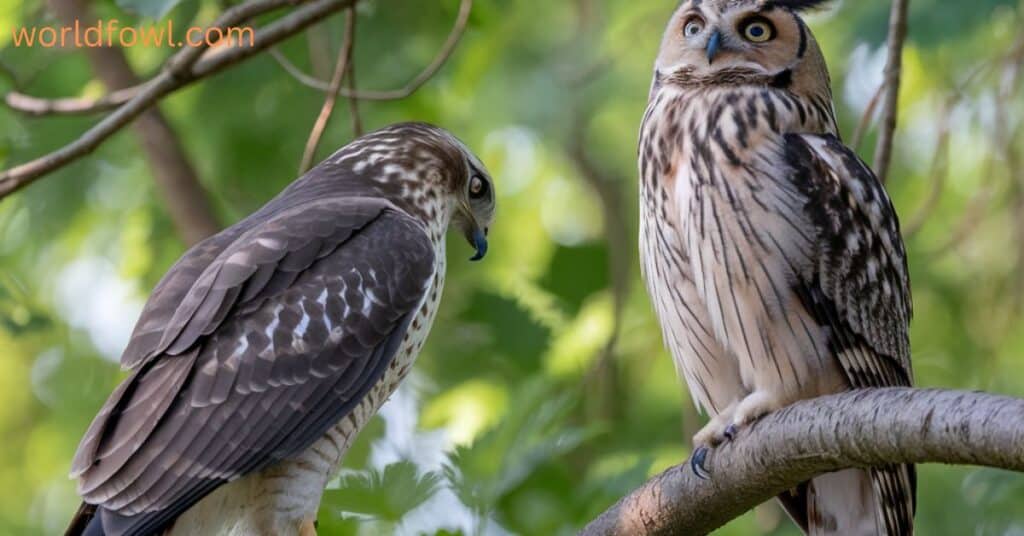In the captivating world of avian predators, few rivalries evoke as much intrigue as the Owl vs Hawk confrontation. Both of these remarkable creatures stand as icons of nature’s evolutionary prowess, each boasting a unique set of adaptations that make them formidable hunters in their own right. But what happens when these titans meet in the skies? Who emerges victorious when talons and techniques collide?
This comprehensive guide delves deep into their evolutionary backgrounds, combat statistics, sensory capabilities, and real-life encounters, painting a vivid picture of the dynamics in the Owl vs Hawk rivalry. By exploring these themes in detail, we can better appreciate the intricate balance of nature and the adaptations that allow these birds to thrive.
The Evolution of Aerial Excellence

To truly understand the Owl vs Hawk rivalry, we must explore their evolutionary histories. The ancestors of both birds adapted over millions of years, honing their skills as apex predators. While they share a common lineage as birds of prey, the paths they took diverged dramatically, resulting in the specialized hunters we see today.
Understanding Convergent Evolution
Convergent evolution occurs when different species develop similar traits in response to similar environmental challenges. In the case of owls and hawks, both have evolved exceptional hunting capabilities, but their adaptations reflect their distinct lifestyles.
- Owls: Primarily nocturnal hunters, owls have evolved to operate in low-light conditions. Their silent flight, acute hearing, and excellent night vision make them exceptional predators in the dark. They can swoop down on unsuspecting prey without a sound, thanks to their specialized feather structure.
- Hawks: In contrast, hawks are diurnal predators, relying on speed and agility during the day. Their sharp eyesight allows them to spot prey from great distances, while their powerful muscles enable high-speed chases through the sky.
This evolutionary divergence highlights the different survival strategies that owls and hawks have adopted. As Dr. Sarah Chen, an ornithologist at the International Raptor Research Center, puts it, “Owls and hawks are like two perfectly designed fighter jets, optimized for different combat conditions.”
you may also like : Why Do Crows Chase Hawks? Do Crows Hate Hawks?
The Fossil Record: A Glimpse into the Past
Fossil evidence suggests that birds of prey have existed for over 60 million years. The earliest raptors were likely small, forest-dwelling birds that gradually adapted to a more predatory lifestyle. As ecosystems evolved, so did their hunting strategies.
- Owls: Fossilized remains of ancient owls indicate that they were already well-adapted for nighttime hunting by the time they appeared in the fossil record. Their distinctive facial discs, which help funnel sound, have been a hallmark of their design for millions of years.
- Hawks: Similarly, the ancestors of modern hawks evolved adaptations that favored speed and agility. The ability to soar at great heights allowed them to survey large areas for potential prey, leading to the development of their impressive visual acuity.
Meet the Main Contenders in the Owl vs Hawk Showdown
When discussing the Owl vs Hawk rivalry, specific species stand out due to their unique adaptations and hunting techniques. Let’s take a closer look at these elite aerial predators.
Premier Owl Representatives
Great Horned Owl (Bubo virginianus)

- Habitat: Found across North America, from urban areas to remote forests.
- Size: Up to 25 inches tall, with a wingspan of 40-60 inches.
- Weight: Ranges from 2 to 5.5 pounds.
- Diet: Highly adaptable; feeds on rodents, birds, and even larger prey like deer.
- Special Traits: Known for exceptional strength and adaptability to diverse habitats. Their tufted ears give them a distinctive appearance.
Eurasian Eagle-Owl (Bubo bubo)

- Habitat: Native to Europe and parts of Asia, often found in forests and mountains.
- Size: Up to 28 inches tall, with a wingspan of 50-60 inches.
- Weight: Typically weighs between 3 to 10 pounds.
- Diet: Known to take prey four times its size, including rabbits and large birds.
- Special Traits: Possesses remarkable night vision, allowing it to hunt effectively in low light. Its large size and powerful build make it one of the most formidable owls.
Hawk Division Leaders
Red-tailed Hawk (Buteo jamaicensis)

- Habitat: Widespread across North America, from deserts to forests.
- Size: Ranges from 18 to 26 inches tall, with a wingspan of 45-52 inches.
- Weight: Generally weighs between 1.5 to 3.5 pounds.
- Diet: Primarily feeds on small mammals, birds, and reptiles.
- Special Traits: Known as the master of high-speed aerial pursuits, they utilize their keen eyesight to spot prey from great heights.
Northern Goshawk (Accipiter gentilis)

- Habitat: Found in forests across North America, Europe, and Asia.
- Size: Ranges from 18 to 24 inches tall, with a wingspan of 32-40 inches.
- Weight: Typically weighs between 1.5 to 3.5 pounds.
- Diet: Prefers small to medium-sized birds and mammals.
- Special Traits: Known for remarkable maneuverability and advanced pursuit-predator tactics, making it an expert in forest hunting.
Combat Statistics Overview
To gain insight into the strengths of each competitor in the Owl vs Hawk showdown, we can examine some critical combat statistics. These metrics illustrate how each bird is uniquely equipped for its hunting style.
| Combat Metric | Great Horned Owl | Red-tailed Hawk |
| Maximum Grip Strength | 500 psi | 200 psi |
| Top Flight Speed | 40 mph | 120 mph |
| Visual Acuity | 100x human (night) | 8x human (day) |
| Strike Success Rate | 85% | 90% |
| Stealth Rating | Nearly silent | Standard |
Analyzing the Combat Metrics
The table above provides a clear comparison between the two species:
- Grip Strength: The Great Horned Owl’s superior grip strength is essential for capturing and subduing prey. This power gives it an edge in hand-to-hand combat situations.
- Flight Speed: The Red-tailed Hawk excels in speed, enabling it to chase down fast-moving prey during the day.
- Visual Acuity: Owls possess extraordinary night vision, making them lethal hunters in low-light conditions, while hawks are designed for clarity and precision during the day.
- Strike Success Rate: Both species are highly efficient, with hawks having a slight advantage during the day, while owls shine at night.
- Stealth: The ability of owls to approach silently is a significant tactical advantage in ambush situations.
Advanced Weaponry in Nature
Both owls and hawks boast advanced adaptations that enhance their hunting capabilities. Understanding these biological “weapons” is crucial in evaluating the Owl vs Hawk dynamics.
you may also like : Do Hawks Attack Humans? Why Are Hawks Aggressive To People?
The Owl’s Silent Warfare Technology

Owls are renowned for their ability to hunt silently, a trait that provides them with a significant advantage during nighttime hunts. Their feather structures have evolved to reduce noise, allowing them to approach prey without detection.
Key Features of Owl Stealth
- Serrated Leading Edges: The front edges of their wings are serrated, which disrupts airflow and reduces turbulence, resulting in quieter flight.
- Velvet-like Feather Texture: The soft texture of their feathers absorbs sound, further minimizing noise.
- Flexible Fringes: The trailing edges of their wings are flexible, allowing them to glide with minimal noise.
Sound Suppression Metrics:
- Flight Noise Reduction: Up to 90% quieter than other birds.
- Frequency Dampening Range: Effective in the 100-2000 Hz range, critical for hearing prey in the dark.
- Background Noise Differential: Maintains a sound level differential of <2 dB, making it nearly impossible for prey to hear them approaching.
The Hawk’s High-Performance Combat Systems

Hawks, in contrast, are designed for high-speed hunting during the day. Their adaptations reflect the need for speed and agility, allowing them to chase down agile prey.
Performance Metrics for Hawks
- Maximum Dive Speed: Hawks can reach speeds of over 120 mph when diving, making them some of the fastest birds in the world.
- G-force Tolerance: Capable of withstanding up to 8G during rapid maneuvers, hawks have evolved strong muscular systems to support such intense forces.
- Turn Radius at Speed: They can execute sharp turns with a radius of only 3-4 feet, allowing them to pivot quickly during chases.
Wing Loading Optimization
Hawks can optimize their wing structure for various flight conditions, improving their efficiency and performance.
| Metric | Value |
| Surface Area Adjustment | ±25% |
| Aspect Ratio Variation | 4.5-6.8 |
| Dynamic Soaring Efficiency | 89% |
This level of aerodynamic efficiency is crucial for their hunting success, allowing them to adapt to changing conditions and maximize their hunting effectiveness.
Sensory Warfare Systems
In the Owl vs Hawk dynamic, sensory systems play a critical role in hunting success. Both species rely on specialized adaptations to locate and track their prey, but their methods differ significantly.
Visual Combat Systems
Hawk Vision Specifications
- Resolution: Hawks have about 8x the visual acuity of humans, enabling them to spot prey from considerable distances.
- Color Spectrum Detection: Their eyes can detect colors in the UV-visible range, allowing them to see patterns and markings on prey that are invisible to humans.
- Motion Tracking: Hawks can track movement at over 100 frames per second, giving them an edge in dynamic environments.
- Target Acquisition Range: They can identify prey from over 1 mile away.
Owl Vision Adaptations
- Low-light Enhancement: Owls have evolved eyes that can amplify low light, providing about 100x human capability in darkness.
- Light Amplification: Specialized retinal structures, such as rod cells, enhance their ability to see in low light.
- Motion Detection Threshold: They can detect motion in lighting conditions as low as 0.1 lux, making them extremely effective nocturnal hunters.
- Depth Perception: Enhanced binocular vision allows for precise judgment of distances when swooping in on prey.
As Dr. Elena Rodriguez, a visual ecology researcher, explains, “The differences in visual capabilities reflect the specialized optimization for their respective hunting environments.”
Acoustic Warfare Capabilities
Owls are particularly adept at using sound to locate prey, especially in total darkness. Their auditory systems are finely tuned for detecting even the faintest sounds.
Owl Audio Systems
- Frequency Detection Range: Owls can detect sounds within the 200-12,000 Hz range, allowing them to hear prey moving beneath snow or foliage.
- Directional Accuracy: Their ears can pinpoint sounds with an accuracy of ±1 degree, giving them an edge in locating prey.
- Prey Detection Depth: They can detect prey buried up to 2 feet under snow or other substrates.
- Acoustic Targeting Time: They can pinpoint the location of a sound in less than 0.01 seconds.
In contrast, hawks rely primarily on their superior vision for prey detection, though they can also use their hearing to some extent.
you may also like : 11 Types of Owls In Ontario (With Photos)
Combat Engagement Analysis: Daytime vs Nighttime Operations
The circumstances of a confrontation between an owl and a hawk can greatly influence the outcome. Understanding the dynamics of their encounters is key to analyzing the Owl vs Hawk rivalry.
Daytime Operations
During daylight, hawks demonstrate clear tactical advantages due to their physical adaptations:
Superior Maneuverability
- Better Thermal Utilization: Hawks can take advantage of thermals to gain altitude effortlessly, aiding their search for prey.
- Enhanced Speed Control: Their muscular build allows for quick acceleration and deceleration, essential during high-speed pursuits.
- Superior Pursuit Capabilities: Hawks can engage in high-speed chases, using their agility and speed to catch agile prey.
Visual Dominance
- Better Target Tracking: Their acute vision allows them to track fast-moving prey across open landscapes.
- Enhanced Distance Judgment: Hawks can accurately judge distances, which is crucial for successful strikes.
- Superior Motion Prediction: Their ability to predict the movements of prey gives them a tactical edge in hunting.
Nighttime Operations
As darkness falls, owls take the upper hand, employing their unique adaptations for hunting:
Stealth Advantages
- Silent Approach Capability: The ability to fly without making a sound allows owls to ambush prey successfully.
- Superior Ambush Tactics: Owls can wait patiently and strike with incredible speed, often catching prey off-guard.
- Enhanced Surprise Factor: The element of surprise is crucial in nocturnal hunts, and owls excel at this.
Sensory Superiority
- Better Sound Location: Owls can detect sounds more accurately in the dark, allowing them to locate prey hidden from view.
- Superior Low-light Vision: Their ability to see in low light gives them a significant advantage during nighttime hunts.
- Enhanced Spatial Awareness: Owls can navigate and hunt effectively in complex environments, such as dense forests.
Field Research: Real Combat Scenarios
To gain practical insights into the Owl vs Hawk dynamic, researchers have documented real-life encounters between these two predators. Let’s explore a few case studies that illustrate their interactions.
Case Study 1: Montana Territory Dispute
- Location: Glacier National Park
- Date: October 2023
- Duration: 4.5 minutes
Encounter Details
- Participants: Great Horned Owl vs. Red-tailed Hawk
- Time: Dawn transition period, just before full daylight.
- Temperature: 42°F, clear skies.
Outcome
The encounter began as the Great Horned Owl was perched quietly, waiting for the perfect moment to hunt. The Red-tailed Hawk, soaring above, spotted the owl and began circling.
The owl, aware of the hawk’s presence, remained still. As the hawk descended, attempting to intimidate the owl, the Great Horned Owl took advantage of its grip strength and launched an ambush. The owl successfully captured a nearby rodent that had been startled by the hawk’s approach, demonstrating its hunting prowess and adaptability.
Case Study 2: Arizona Desert Engagement
- Location: Sonoran Desert Research Station
- Date: July 2023
- Duration: 2.3 minutes
Encounter Details
- Participants: Harris’s Hawk vs. Great Horned Owl
- Time: Mid-day, under bright sunlight.
- Temperature: 98°F, high visibility.
Outcome
In this encounter, a pair of Harris’s Hawks were hunting in pairs when they noticed the Great Horned Owl resting in the shade. The hawks approached, utilizing their social hunting tactics. The owl, aware of the potential threat, decided to withdraw to avoid conflict.
The tactical withdrawal showcased the Great Horned Owl’s adaptability and the respect that exists between these two apex predators. Both parties understood the risks of engaging in direct combat, demonstrating an inherent wisdom in their behaviors.
you may also like : Do Owls Poop – The Juicy Truth
Conservation Impact Analysis
The dynamics of the Owl vs Hawk rivalry extend beyond mere competition; they have implications for conservation and ecosystem management. Understanding these interactions is vital for preserving their habitats and ensuring healthy populations.
Population Dynamics
Recent studies show the following trends in the populations of our contenders:
| Species | Annual Growth Rate | Current Population Trend | Notes |
| Red-tailed Hawk | +2.5% | Increasing | Highly adaptable to various habitats. |
| Great Horned Owl | Stable | Stable population | Faces threats from habitat loss. |
| Territorial Overlap | 1.2% annually | Increasing | More overlap in hunting territories due to habitat changes. |
| Human Impact Zones | 65% of range | Significant threat | Urbanization and agriculture impact habitats. |
Ecological Role Assessment
The coexistence of owls and hawks is crucial for maintaining balanced ecosystems. They each play distinct roles in controlling populations of prey species and contributing to biodiversity.
Predator-Prey Balance
- Small Mammal Control: Both owls and hawks regulate small mammal populations, preventing overpopulation and subsequent ecosystem imbalances.
- Bird Population Regulation: Their predation of smaller bird species helps maintain healthy bird communities and biodiversity.
- Disease Vector Management: By controlling rodent populations, these birds of prey help reduce the spread of diseases carried by these mammals.
Ecosystem Services
The ecological services provided by owls and hawks have significant economic implications:
- Agricultural Pest Control Value: Estimates suggest that raptors contribute approximately $23 billion annually in pest control for agriculture.
- Biodiversity Maintenance: Their predation supports diverse ecosystems, ensuring the survival of various species.
- Natural Selection Pressure: By exerting predation pressure, these birds help maintain the health of prey populations through natural selection.
Conclusion: Nature’s Aerial Masters
The Owl vs Hawk rivalry is a testament to nature’s intricate designs and evolutionary ingenuity. Both species showcase unique adaptations that make them exceptional hunters, embodying the delicate balance of life in their ecosystems.
As we continue to study these majestic birds and their interactions, we gain valuable insights into the importance of conservation and biodiversity. Protecting their habitats and understanding their roles in the ecosystem is essential for ensuring that they thrive for generations to come.
In essence, the story of owls and hawks transcends the question of which is superior. It illustrates the beauty of nature’s adaptations and the interconnectedness of all living things. By promoting understanding and conservation, we can help preserve the delicate balance that allows these magnificent aerial predators to coexist.
In the end, the Owl vs Hawk dynamic is not just about competition; it’s about celebrating the diverse strategies that different species employ to survive and thrive in an ever-changing world.

Henry James is a seasoned blogger and a passionate storyteller on “World Fowl.” With years of experience crafting engaging content, he brings a unique blend of expertise and creativity to his writing. Henry specializes in exploring diverse topics with depth and clarity, captivating readers worldwide.







